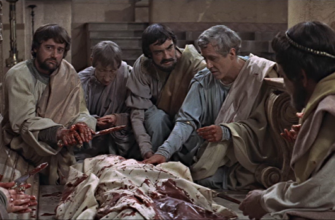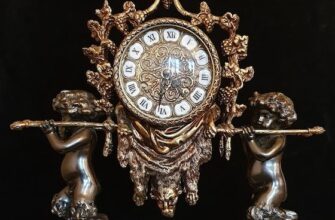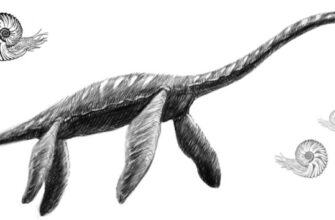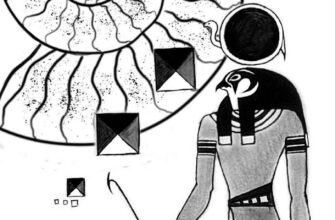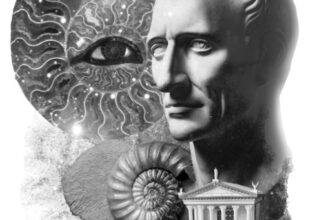Disclaimer: this chapter is translated by DeepL. The text will be updated after the translation has been corrected by a professional editor.
Julius Caesar was chosen by the priesthood of Rome as Pontifex Maximus, the Chief High Priest, even before he was elected dictator, the title given to the first person of Rome at the time. Indeed, the council of priests of various Roman cults has chosen well.
Theoretically, that is, ideally, the Chief High Priest should equally respect all the gods whose cults were established in Rome. In practice, perfect equality of respect is impossible, of course, but it is not customary among High Priests to openly discuss their personal preferences. So then, under what circumstances one could find out which one of the Roman gods Julius Caesar has valued above the others? What cult was the most important for the prosperity of the state in his opinion? Who did Julius Caesar, the Chief High Priest of Rome, regarded as the key god, one to whom the general public would naturally try to pay less attention than to the others? And, of course, the general public would work really hard to distort the true meaning of the cult in question.
So how can we find out? We could, for example, overhear a conversation between Julius Caesar and his wife just before his sacrificial death. A ritual of which cult he advised her personally not to neglect? The preservation of which cult Caesar bequeathed to her as the widow of the High Priest to observe? It’s the most valuable moment revealing the deep knowledge possessed by someone whose position forces him to keep silent on many matters.
And, what a surprise, Shakespeare shows us this moment – in Julius Caesar. The “what a surprise” part is, of course, ironic. Shakespeare is Shakespeare. He never neglects the key moments. So, under the blessing of Julius Caesar, there is a mystery of the Faunalia, also known as the Lupercalia in Rome. Next to Caesar is his wife Calpurnia. (Julius Caesar act 1, scene 2).

CAESAR: Calphurnia.
CALPHURNIA: Here, my lord.
CAESAR: Stand you directly in Antonius’ way
When he doth run his course. – Antonius.
ANTONY: Caesar, my lord.
CAESAR: Forget not in your speed, Antonius,
To touch Calphurnia, for our elders say
The barren, touchèd in this holy chase,
Shake off their sterile curse.
ANTONY: I shall remember.
When Caesar says “Do this,” it is performed.
CAESAR: Set on and leave no ceremony out. Sennet.
SOOTHSAYER: Caesar.
CAESAR: Ha! Who calls?
So Caesar advises his wife to participate in the mysteries called the Faunalia and in doing so not to omit any detail of the rituals. The Faunalia is interesting if only because this festival was open to the general public. This means that everyone, any common person, was a participant in the mysteries. Looking forward, we should say that the commoners used to represent the Rams in these mysteries.
The Rams do not play part in any other mysteries, therefore the commoners are not allowed in the mysteries of the other cults. And yet, in spite of the presence of a huge flock of “rams”, there is still a sacred meaning in the Lupercalia mysteries, which is not accessible particularly to the leaders of the Rams, the Goats. And one of the goals of the priests in charge of the Faunalia is actually to expose the Goats.
Mark Antony, the traitor to the cause of the true High Priests, the future partner of Cleopatra, and the enemy of Caesar’s spiritual successor Octavian, has been most fittingly delegated a role of the Goat in the mysteries. During the Faunalias, the Goat is the one who runs around in a loincloth made of a fresh piece of goat skin and whips whoever he can with a belt cut out of goat skin.
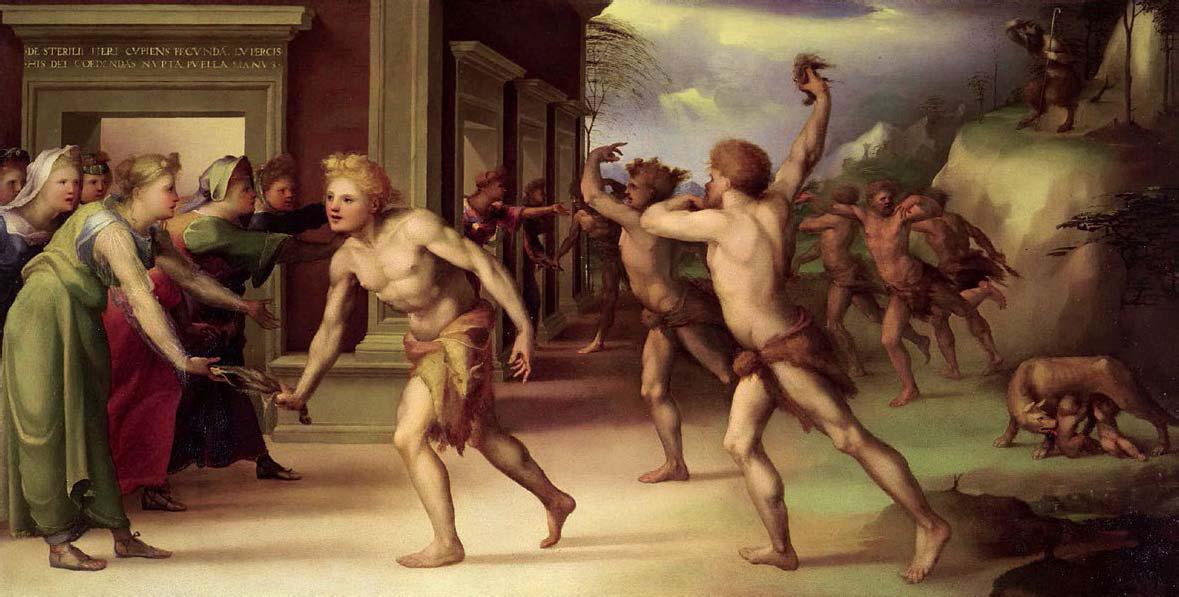
The meaning of the Goat is derived from the general sense of the Faun’s mysteries. The Faun, or Lupercus, as we shall see below, is the god of scientific enlightenment and technology. He is also a guide from the World of Poseidon to the Middle World. Clearly, The Faun must be portrayed quite differently by those who understand the nature of the god and those who do not. Those who do understand depict the Faun or Lupercus with legs and hooves of a stag. As a matter of fact, sailors on whaling ships, the counterparts of cannibals in Poseidon’s World, used to say “they are wearing the horns (antlers) of a stag” about married men living settled life on the mainland.
It’s the same sailors who brag that they’ve got at least two “wives” in each and every harbor. Unlike the sailors, the “stags” do not make a cult out of cheating on their wives. And, yes, when the wives of the “stags” do cheat on their husbands, such husbands are referred to as “wearing the horns” even by their neighbors. A “stag” is probably a bit milder description than “the one wearing horns” is. So then, the Faun is a “patron saint” of the “stags” in the Middle World, and above all of those who have the prospect of getting out of their puppet-like condition into the elevated state of priesthood. So, in some instances, those in the know might consider that to be “wearing horns” is actually a praise.
The link between true natural sciences and the “stags” is obvious. During Stalin’s times in the USSR it was also well understood that true science can only be driven by those scientists who do not cheat on their wives. Womanizers are not capable of doing true science. They are only capable of creating an appearance of doing science, which is the same as pseudoscience. That’s the reasoning behind all these purges of scientists under Stalin, that were based on upholding family values and moral principles, and behind all these meetings of working collectives, where women testified about their husbands cheating on them (even if it was only in their imagination). So, a “priest of Science’, even if not a true Priest, is at least a “stag”. But by no means he could be a “sailor”, someone who has “two wives in every harbor”. This idea is demonstrated in the canonical depiction of the Faun as an artisan with the antlers and legs of a stag.
The Lupercalia mysteries under Caesar as a Chief High Priest formally begin with the sacrifice of a goat to the Faun in a sacred cave. When the goat is slaughtered, everyone present must laugh. Then the skin of the humiliated goat is cut into pieces for loincloths and belts. The belts are to whip anyone who ends up in the way of the runners. And only men of a certain type can receive these belts. Only those who are disgraced in the eyes of the priests and who are fit to be called “the goats” because of their character traits.
Womanizing is not the only characteristic feature of a “goat”. Cooperation with the World of Darkness is also a good indication, and it manifests in soul-distorting betrayals of Comradeship which lead to building up a potential for becoming a “leader of the sheep”. The Goats can also be distinguished by extremely high levels of self confidence. An intelligent man knows that he knows nothing, so he always has doubts and in order to avoid mistakes he seeks to compose a collective mind, to get advice. And he does so not only until the first appearance of gray hair on his temples, but sometimes to the very end of his life. The typical “goat”, on the other hand, has not even started shaving yet, but he is already confident about everything. He needs no collective mind at all. A good example of a “goat” is Mark Antony, a traitor of Octavian and of the World of Light in general. Antony even used to follow Cleopatra as she, disguised as a tavern maid, was going out at night to visit the harbor areas for obvious reasons. She would not have made out with mere sailors. The average sailor can no longer be corrupted, as he’s already got his “two wives” in every harbor anyways. A delicacy for someone like Cleopatra are only those who can be deceived into a great moral fall and thus killed paleontologically. Cleopatra’s secret role model is Medusa Gorgon. However, not at the time when Medusa was exposed by Athena as a monster by having her hair replaced with snakes, but when Medusa still had hair and spent her time in harbors, not only as clearly a prostitute but also as a molester. Of course, Medusa Gorgon is nothing more than a subconscious image for Cleopatra, as it is very unlikely that Cleopatra has spiritually evolved enough to see her faults through the prism of sacred knowledge.
Many around us, even those interested in antiquity, assume that it’s the priests themselves who should be running around at the festival of Faunalia with the belts made of a “humiliated goat” skin in their hands. But the fact that Julius Caesar approved of Mark Antony’s participation as a Goat is just the thing to indicate how correct the choice of priests singling out Antony was. Otherwise Julius Caesar as Chief High Priest would have had to intervene and correct the inaccuracy in the course of the mysteries.
So, during the Faunalia the Goats ran around the streets of Rome and whipped (“gored”) some of those who wished to participate in the mysteries. Obviously, not everyone could get “gored”, since if all the inhabitants of Rome were to be whipped, the arms of the “goats” would have fallen apart from exhaustion. And so it was believed a person hit by a goat during the mysteries had a dramatic improvement in the well-being of their family. One particular improvement was a cure for infertility. It so happens that two-legged “goats” hate people and it’s the people the hate the most they wish to whip. So they want to hurt precisely those who are capable of receiving a blessing during the Faunalia. There is nothing esoteric here, and we will explain the whole process in a moment.
The cure is not magical at all, it’s just a result of a psychological impact made by the priests. I can say it with some confidence, because I myself used to treat infertility in women when I was young. Don’t get me wrong, I didn’t have intercourse with them. It was classical psychotherapy. Psychosomatic illnesses are the result of a distorted understanding of the world order. So if a particular misconception associated with the disease is corrected, the disease will be gone as well. Infertility is a great example. Incidentally, of all the psychosomatic illnesses infertility is one of the easiest to cure, due to the fact that it is the easiest to treat with words.
How exactly did the worldview of the participants in mysteries change? To be exact, what changed in the worldview of those few of the participants, who allowed themselves to think beyond the tedious sequence of rituals and about the meaning of the mysteries as a whole? It is not difficult to find out that some women, or rather a lot of them, claim that disfunctions in marital sex life are due to the husband not being a “goat” enough. That’s what they basically tell their husbands: cheat on me to reignite the passion between us. Often, if the husband does not feel like cheating, for example, for religious reasons, the wife might bring one of her female friends over, get the husband drunk, and make sure he goes to bed with her friend. Surprisingly, this technique is not at all uncommon.
Simply speaking, in terms of mythology, the wives force their husbands to worship the Goats, or other goat-like entities, like the Satyrs. The ignorant ones, or rather those who have fallen spiritually by justifying certain sins, often identify the Faun with the Satyr. But these deities are conceptually opposite. The Satyr, indeed, has goat-like features, but the Faun has features of a stag. And if the Satyr has horns, the Faun has antlers. And in everything else they are completely unlike. For example, the Satyrs are not interested in natural science at all. And it’s not the Satyr who brings about the blessed rulers, but, on the contrary, it’s the Faun, also known as Pan.
Satyr-loving women, that is, those who coerce their husbands into adultery, not only theoretically presume that all their pains and ill-health come from the lack of immersion in the Dark World, but also put their theory to practice. Such beliefs manifest particularly in the fact that the women try to drown both pain and sorrow with alcohol or other drugs. The pain can indeed be relieved by intoxication, but only for a short time. For a long lasting effect it is necessary to get rid of goat-related delusions, i.e. first to begin respecting the Faun, then Zeus with Hecate, and ultimately Athena.
The belief about what is the source of misery and pain accounts for an important distinction in one’s worldview. Clearly, if one unconsciously believes that relief will come as a result of an even greater immersion in sin, one’s life will be dedicated to the pursuit of new experiences of such immersion, to so-called “search for pleasure”. But if one understands that the source of pain is the Goats and the “goat” worldview within oneself, then one can start striving for freedom from the Goats, i.e. seeking the Truth, the Collective Mind, and the ways to help the Mutational Collective.
So the subject of dealing with the pain is what the mysteries of the Faun handle using imagery as a medium. Until life actually hits you, it’s hard to figure out that the pain comes not from the lack of goat-like qualities, as the contrarians like to believe, but from the Goats themselves and from following their example. So, if you get quite a strong blow with a belt made from the skin of a humiliated goat, you may not understand the meaning right away, but you will certainly remember it at least. And if you will finally allow yourself to understand the meaning, in time, it will make you think.
This is why the “humiliated” belts are given to someone like Mark Antony, a heavy drinker, womanizer and traitor, incapable of self restraint. Alternatively, the belts could be given to the very young men of certain qualities. That is, to those who always confidently and loudly voice their demands, asking for changes according to their defective worldview – something that always leads to bad times. They are the ones who engage in all sorts of violent and disruptive behavior while drunk or on drugs – just like the goat-legged Satyrs. You can find a good example of those who could wave the goat belts like banners in the days of Luperkaria in Russian prisons, among some of the inmates who are called “goats”. The point is, the ones with the spirit of a goat would be especially cruel in beating women who are spiritually unlike them. That is, they would target women, who not only like to participate in the ancient mysteries recommended by Julius Caesar to his wife, but also to contemplate the meaning of what they have seen.
And so, during the mysteries, women, too, were given the opportunity to experience that the real source of pain are the Goats (at least, they were able to have such experience at the level of everyday life and without much actual damage involved, like an extramarital affair or child). First, that kind of experience comes from the actual pain after being hit with a belt made from a “humiliated” goat skin. Second, women may have wondered why the Goats chose to hit some of them and avoided the others. Some women might simply remember it first, then think about it a little more, and then, gradually, figure it out. And if she starts to figure things out, that is basically the end of infertility and improvement of family relations.
The expression “to figure it out” requires some clarification in the context of the Faunalia. Again, the main feature of all mysteries is that outsiders are not allowed. Only initiates are allowed, as participants in some sort of performance. In other words, everyone taking part in the mysteries has a role to play. What exactly is the role of an average city resident when the Goat runs towards him with the intention to hit either him or some other resident in the crowd? Actually, it’s the role of the Ram.
The Ram is a sacred symbol. The sheep follow the goats to the slaughterhouse because they consider the goat to be a more perfect creature than themselves. In other words, there is some sort of an ‘imperfect goat’ inside every sheep. However, the Ram combines two opposite aspects: apart from the “goat” inside, it has an “ammonite” on the outside. Since ancient times, anyone who has seen an ammonite has compared its shape to that of a ram’s curled horns. The Ram differs from the Goat precisely in that the Goat has no organic bond with the Ammonite, whereas the Ram still has one, albeit peripheral and superficial. If the Rams want to develop their personalities, they must be willing to squeeze out the alien, “goat” aspect, and in the meantime, to extend the organic, “ammonite” aspect. The Ram with such a desire is no longer a sheep. Such Rams won’t follow the Goats to the slaughter anymore, but instead they would start to align themselves with the Faun as a fully realized personality moving toward the Portal of Hecate.
So, the first step in the process of approaching the portal of Hecate is to understand that the source of every pain, psychological and physical, is the Goat. The Faunalia are meant to facilitate this advancement.
Looking forward: besides the Goats, Brutus’ army also consists of the Rams, whose horns are about to fall off or have already fallen off – i.e. their link with the moral principles of the Ammonites is by all means lost.
What do you think, would the Goats like Antony be willing to participate in the mysteries the following year, if it were explained to them that they had been chosen simply because they were considered the best possible actual “goats” perfectly fit for the role? Maybe I’m not a good judge of human character at all, but it seems to me fewer people would be still willing to run with a goatskin whip after such a disclosure. Not everyone is willing to be exposed like that to the people they know in the crowd.
Of course, someone would pick up the whip again anyways. For example, someone who is a counterpart of modern “goats” in Russian prisons, i.e. of the inmates cooperating with the prison administration. They are the ones who are happy to take and to give orders. And they’re thieves, too. When I was in prison, the “goats” used to steal my special diet food, which I was entitled to because of my diabetes condition. It happened both in Butyrka prison in Moscow and in a pre-trial detention facility in Tula. And the “goats” in Tula used to steal even more shamelessly than the “goats” in Moscow did. Notably, the guards would always cover up the theft, even though the guards themselves used to call the thieves – “goats”. In any case, it makes sense that the priests of the Faun haven’t explained to the crowd who the Goats really are. Those in the crowd who have guessed on their own will truly get the deepest insight into the mysteries. And, on the other hand, someone among the Goats themselves, having grasped the real meaning of the offer to run around with a whip during the Faunalia, will hold a grudge for life. He will live for revenge. He will make them pay for the insult. And that’s who Brutus is. He is an avenger.
Truly a lot is written on behalf of Brutus the prosecutor! He is a model democrat, they say. He has killed the High Priest, they say. He has accused him and he has killed him. And so on. But the most important thing is not written anywhere – that the priests of Rome could not miss the fact that Brutus was a jerk, an exemplary Goat. We will discuss this aspect of Brutus’s character further below.
There are vague historical references about some women taking their clothes off during the Lupercalia. It’s unclear, i.e. it hasn’t been analyzed, what kind of women they were. Also, these ladies openly, if not demonstratively, engaged in sexual intercourse. And here’s the question: with what type of partners did they have intercourse? Could it be someone like Julius Caesar, the High Priest? Or, on the contrary, could that be one of these very Goats?
A healthy woman somewhat capable of a good judgment would be sick of the Goats. But theoretically the mysteries would be incomplete without a possibility to observe not only the Goats but their women as well. It’s difficult to immediately learn how to distinguish one type of woman from another. The women who serve the Goats are often very clean-looking and appear to be religiously devoted. That’s how they disguise themselves, pretending they’re not cheap sluts at all. Generally speaking, these women are of Cleopatra’s type. Funny thing to say, because Cleopatra is usually adored and admired as a historical figure. Well, she is admired only by those who haven’t yet figured out who the Faunus, the Satyr and Hephaestus are, and, perhaps, never will.
The fact that this type of woman is deeply religious is spot on. However, it is necessary to clarify that they happen to believe only in modern religions and not in ancient ones, which contain sacred knowledge of the priests about the Dragons. These ladies could go as far as to justify a public sexual intercourse with their “religious” views. But apart from the Goats like Antony, there’s hardly anyone who’d go for this type of woman. Unless it’s someone who hasn’t figured out this type of woman yet. Or someone under the influence of alcohol. Or maybe even someone coerced into doing it by his own unfaithful wife seeking an excuse for her infidelity.
So, a goat is not an animal sacred to the Faun at all. The killing of humiliated goats took place against the background of the Faun’s protection of other animals (i.e. all except goats and dogs) even from the blows of the animal handlers. Twice a year, during the Faunalia, beating and forcing to work any domestic animals, including slaves, was forbidden under threat of punishment.
Incidentally, during the Faunalia (Lupercalia), dogs were also sacrificed alongside the goats. Could these be bitches? It is interesting that the words “dog”, “goat” and “bitch” are used as insults to this day in the Russian language. The wolf, on the other hand, was nearly deified in the cult of the Faun for his positive input in the presentation of the Faun’s Portal.
The festival of the Lupercalia, including the running of the Goats with the goatskin belts mentioned in Julius Caesar, starts with Palatine, the central sacred hill in Rome. Namely, with the Cave of Lupercal, where, according to legend, a She-wolf nurtured the future founders and first kings of Rome, Remus and Romulus.
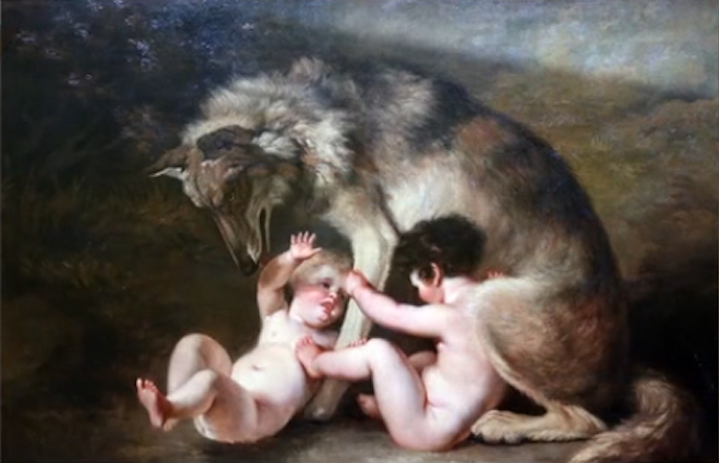
Well, you might say, but what does the Faun have to do with it, if in most sources, he is not even mentioned among those present in the Cave? Yes, the sources don’t say anything about this, but it’s easy to guess on your own that the Faun had to be in that cave. It was the Faun who had protected the She-wolf from the influence of the Goats, considering that the goats are those who stir up anger, hatred, and aggression against the creators. The Faun most likely had to drive out from the Cave the entire spectrum of both obvious and hidden varieties of the Goat forms. As a consequence, the She-wolf has been exceptionally peaceful with Remus and Romulus. She has even nursed them with her milk. The humiliation and expulsion of goats was just as important for the existence, survival and development of the founders as the ability of the She-wolf to nurture them with her milk. Therefore, the Faun must have been in the Cave.
Without the Faun there might have been no Rome as the cultural center of the world.
Technically, the words “Faunalia” and “Lupercalia” have the same meaning. But there is a difference. When one says “Lupercal” relating to the cave at the foot of the Palatine hill, one is reminded of the word “lupus”, which means “wolf” in Latin and there are no reasons for raising any questions about the Faun. But when the mysteries are called “the Faunalia”, the question arises: what has the Faun got to do with it? “The Faunalia” is a more enlightening name, although for beginners, lest they get their minds blown, “the Lupercalia” is better.
The Lupercalia does not offer the biggest picture to help comprehend the Faun. A bigger picture is needed. And to see a truly big picture is to realize that the sacred acts of the cult of the Faun were never performed in man-made temples or shrines. All the sacred acts and mysteries were performed in fields, forests and caves. But all this doesn’t mean that the cult of the Faun is simply some sort of a retarded folk custom of begging for a good harvest, which is what reference books usually propose as a postulate.
The fact is that since ancient times the entire spectrum of human character types and, accordingly, of all predictable behaviors associated with these types has often been divided into five parts for simplicity. The uppermost part or Heaven, is the World of Priests. The other four parts preceding it are: the world of the Bottom (of the lowlifes), the World of the Tortoise above it, then the World of the Elephant Herd and on top of them is the World of Attainable Heights (or, if you like, the World of the Land and Mountains). So these are the four preliminary stages of human character development. There is also a fifth preliminary stage. It is situated below the Bottom World. And it will not be spoken of for now.
The darkest World of the Bottom, is the World of Poseidon and his wife Salacia, the patroness of dockside prostitutes, and also the World of Ares, Hephaestus, Triton, Pallas (not to be confused with Athena Pallas) and so on. And there is its opposite, the World of Light, which is the world of Athena and of all who with open heart aspire to her as to the ultimate possible perfection.
The transition zone, which might as well be called a vestibule or portal, is a domain of the Faun. It’s some sort of a filtration camp. The Faun’s portal lies between the World of the Elephant Herd, where matriarchy prevails, and the World of the Heights, where patriarchy reigns. Alas, both these zones are far from being simply neutral. In Heaven, i.e. in the Enlightened World of Priests, in the World of the Lions, so to speak, are those who have managed to overcome the pain that prohibits learning the inner structure of the world of people. Indeed, many probably know from personal experience how relatively painless it is to penetrate into the sciences of physics, geography, geology, biology, non sacred astronomy, etc., compared to the science of inner structure of individuals and of larger structures, of which the individuals themselves are the parts. Temples are not required for learning the basics of the natural sciences. Fields, forests and caves are good enough – the very places where sacred rites under the patronage of the Faun are performed.
Practice is the criterion of truth. How do you know if you’ve learned anything, say, in agriculture or biology? You can tell by whether your field is producing the crops you intended or something else, like weeds or some other crops. The same goes for geology. A cave and a mine have something in common. What exactly is chipping away at the wall of the mine when you hit it with your pickaxe – is that what you want to mine? And what do you bring back when you return from hunting in the woods?
In the dark World of the Bottom they don’t want to know even that. Geology and physics? Really? In the World of Darkness, they are concerned with seeking a favor of fortune. Fortune is often confused with luck, but they’re not the same thing. Fortune is attracted by drunkenness, by pleasing “fortunate” whores, by crimes like murder and cannibalism, by useless suffering in prison.
Of course, all these fishermen, bandits, cannibals and convicts know nothing of Poseidon, nor of his wife Salacia, the patron saint of “fortunate” whores, nor of their son Triton. Triton, by the way. is the ultimate monster, the voice of the abyss. And all of them are not familiar enough with geology or agriculture to a degree of being capable to enjoy understanding.
The “little fauns” are, figuratively speaking, the children of the Faun. They have already passed through the Faun’s Portal. And those who have passed the Portal no longer seek the favors of fortune. Hunting for fortune, by the way, always leads to some sort of self-destruction, such as getting drunk as a skunk. For example, many people know that fish bite more enthusiastically when the fisherman is drunk. They go fishing while sober and nothing happens. Then they get drunk and the bite starts. The Faun’s disciples don’t care much for “fortunate” fishing or for “fortunate” whores. Ideally, they don’t cheat on their wives at all.
Yes, the Faun’s disciples have become explorers after participation in the Faunalia. But they are only interested in objects of natural science. And since they cannot easily proceed from studying forests, fields and caves to studying people, mutation and evolution, they cannot help their wives with their psychological problems in any way. They cannot help them to eradicate the root causes of their suffering. The help is possible, of course, only if the wife herself wants it, because women are rarely willing to give up the self-justifying position of victimhood. So wives, even the best ones, prefer to get rid of psychological pain in some corrupt way – by adultery or some other version of self-destruction. And so it goes that any “little faun” who would rather not endure the pain of learning unpleasant truths about the inhabitants of the Middle World and to enter the World of Priests will “wear the horns”, no matter how hard-working and successful an expert in anything, even in a rocket science, he is.
This experience of family life is reflected in the Faun’s appearance in the form of antlers and hooves of a stag. Branched antlers. But for Faun himself the antlers are sort of a thing of the past. But only “sort of”. Faun once found strength to notice his “horns” and to call certain aspects of his marriage by their proper names. Thus finding solid ground under his feet, he moves towards the Portal of Hecate on the border between the World of Heights and the World of Priests. That’s where the Portal of Hecate is. And the Faun’s Portal is situated on the previous border leading into the World of the Heights (the Middle World). Faun guides his, figuratively speaking, future children – “little fauns” – through his Portal and toward the Portal of Hecate. The Lupercalia or the Faunalia, is like an integral part of Hecate’s Portal.
Again, the Middle World (the World of Heights, the Patriarchy) is by no means neutral. Its inhabitants fuel the World of Darkness at the very least by refusing to help their entrapped wives to break free from the dark schemes of suffering in the World of Poseidon and Salacia. Simply put, the wife of “the one wearing the horns” cheats on him, and as long as the cheating wife fuels the World of Darkness, the husband fuels it too, through her. Well, he fuels it, but at the same time he also fights it.
So a typical Stag spends his energy fighting two battles: on one side he fights the dark World of Poseidon, and on the other he fights the World of Priests.
Of course, an ideal country is one with a population consisting exclusively of Priests. However, the achievement of the stage of development preceding the ideal one, when a society has the predominance of the Middle World population, i.e. the workers, the Stags, and when by some means the proportion of parasites, aka Poseidonians, is reduced, also leads to the prosperity of the state. This is why the Faun is regarded as a god of state prosperity. The idea of the Faun as a source of prosperity is mentioned even in mainstream textbooks. And even though, prosperity in question is far from the ultimate goal, nevertheless, for a start, it guarantees a breakaway from being a “loser” state with modest results.
Yes, the textbooks do mention that the Faun is not only the god of the fields and caves, but also the god of state prosperity, but the authors have no idea what it has to do with antlers and hooves. Too bad. If they knew better, then the horns of a goat artificially and even falsely attributed to the Faun in some textbooks would have fallen off as well.
It is fundamentally impossible to understand all the essential aspects of the Faun by paying attention only to his positive qualities and not exposing his dark side. And also, if you don’t expose the fake version of the Faun. Every fake is like the original in a number of minor ways. But not entirely. For example, Hephaestus also spends a lot of time studying the crafts, and his wife Aphrodite cheats on him incessantly. But Hephaestus is the fake Faun – because Hephaestus, having been to the Middle World, betrayed it and now belongs entirely to the World of Darkness. To make the distinction clear, we need to find a situation in which the Faun and Hephaestus would act very differently. And the situation is this: Hitler’s attack on the USSR and the events in the occupied territories. The situation we are looking for is described in the book The Young Guard by Alexander Fadeev.
So, in The Young Guard there is Ignat Fomin who lives in the town of Krasnodon in Donbass. Before the occupation, he was considered a Stakhanovite: excellent production results, his picture displayed on the Board of Honor, etc. Well, he appeared to be a model man of the beautiful future. And you might assume he was a faithful Stalinist, too. But then Hitlerites take over Donbass, and Ignat Fomin changes abruptly – he goes to serve the occupants in the ranks of the Ukrainian police. He spares no effort to catch Soviet patriots and former fellow Stakhanovites, and personally participates in the executions of those in his reach. But the members of the “Young Guard” resistance organization hang him. They hang him like a dog on the arch of the market gate. This somewhat Stakhanovite-looking Ignat Fomin is actually a man of Hephaestus’ type. And the partisans of the “Young Guard”, whom Ignat Fomin tried to catch, and who caught and hanged Ignat Fomin instead, are real Stakhanovites – some of them are people of the Faun, some of them are priests.
So, “Stakhanovite” is a term that originated when Comrade Stalin governed the Soviet Union. Stalin possessed the secret method of keeping part of the population enthusiastic. In earlier centuries, some Chief High Priests, such as Julius Caesar, also had this wisdom. This enthusiasm was manifested not only in development of science and arts, but also in industrial labor productivity. A Stakhanovite is precisely the person who at some point succeeded in psychologically liberating themselves to such an extent that he or she showed a very high labor productivity as a result.
And so, a real Stakhanovite is not simply a very productive worker. One can work hard for a variety of reasons. People who have passed through the Portal of the Faun are the ones who have decided that the World of Darkness is intolerably awful. So they have abandoned it and no longer seek the favors of fortune, and instead, they engage exclusively in producing material values (even though they do not produce spiritual ones). But Hephaestus and his counterparts do not hate the World of Darkness at all. This is particularly obvious in the example of Hephaestus himself.
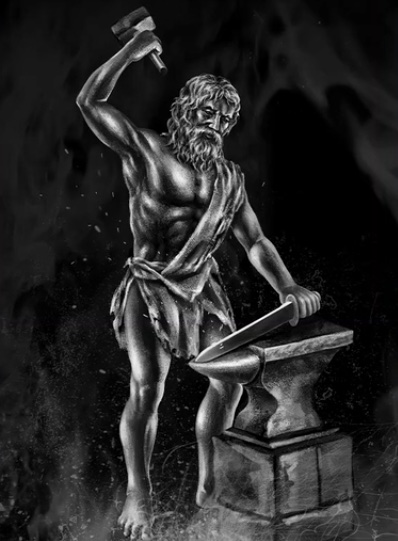
It is known about the lame god Hephaestus that he is “double-jointed”. No one really knows what exactly “double-jointed” means. However, it is clear that Hephaestus is physically handicapped, if not disabled. During WWII the disabled in the USSR were called “white-ticketers”. They would not be able to serve in the army or to join a pirate boarding party. Still, they want to be praised, but in the World of Darkness, those unfit for military service are not praised. So, because of his physical inferiority, Hephaestus the armorer has no chance to become a top dog. To stand out, he begins to do what is almost unheard of in the World of Darkness, that is, he is learning a craft, becoming an armorer. The strong desire to stand out leads him, so to speak, to the “Board of Honor” – just like Ignat Fomin. In other words, the Faun and Hephaestus, despite some similarity in occupation, tools (such as anvil, hammer and forge) and family circumstances (“wearing the horns”) are fundamentally different in their motivations. Hephaestus merely wants to stand out, while the Faun’s goal is to join the Mutational Collective.
So it turns out that in case of invasion, Hephaestus will actively cooperate with the invaders and betray the partisans, while the Faun, on the contrary, will either join the partisans or actively help them in some way.
Similarly, for the clarity of mind, one has to find a situation in which the Faun will act differently from the Satyr. And such situations are comprehended through analysing their respective attitudes towards the other sex. The Satyr is a womanizer and the Faun, on the contrary, is faithful to his spouse. So neither the presence of hooves (of different animals), nor the occasional life in the wild can serve as a reason to identify them. All these details are necessary to understand the meaning of the Faunalia described by Shakespeare, and, consequently, the meaning of the Faun’s Portal.
Looking forward, it must be said that on the Sky Chart, the Portal of the Faun is described by the constellation of Auriga.
Did you enjoy this chapter? Read the next one. Cranach the Elder’s Faun. “Hamlet”
Donations from patrons will be used to translate the book “Sacred Paleontology” from Russian into English. Meniailov has already written more than 50 chapters.
One page of the final professional translation costs us 35 USD. We accept crypto and fiat.
To be continued …




